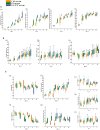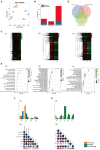Early feeding strategies in lambs affect rumen development and growth performance, with advantages persisting for two weeks after the transition to fattening diets
- PMID: 35968009
- PMCID: PMC9366302
- DOI: 10.3389/fvets.2022.925649
Early feeding strategies in lambs affect rumen development and growth performance, with advantages persisting for two weeks after the transition to fattening diets
Abstract
This study aimed to explore the effects of early feeding strategies on the growth and rumen development of lambs from pre-weaning to the transition to fattening diets. Ninety-six newborn, male lambs with similar body weights were randomly assigned to three treatments: fed starter at 42 days old + weaned at 56 days old (Ctrl, n = 36), fed starter at 7 days old + weaned at 56 days old (ES, n = 36), and fed starter at 7 days old + weaned at 28 days old (ES + EW, n = 24). The fattening diets of all lambs were gradually replaced from 60 to 70 days of age. Six randomly selected lambs from each treatment were slaughtered at 14, 28, 42, 56, 70, and 84 days of age. The results showed that the richness and diversity of rumen microbiota of lambs in the Ctrl group were distinct from those of lambs in the other groups at 42 days of age. Moreover, transcriptome analysis revealed 407, 219, and 1,211 unique differentially expressed genes (DEGs) in the rumen tissue of ES vs. Ctrl, ES vs. ES + EW, and ES + EW vs. Ctrl groups, respectively, at 42 days of age. Different early feeding strategies resulted in differences in ruminal anatomy, morphology, and fermentation in lambs from 42 to 84 days of age (P < 0.05). Lambs in the ES + EW group had a higher average starter diet intake than those in the other groups (P < 0.05) from 28 to 56 days of age, which affected their growth performance. After 42 days of age, the body and carcass weights of lambs in the ES and ES + EW groups were higher than those in the Ctrl group (P < 0.05). These findings demonstrate that feeding lambs with a starter diet at 7 days of age and weaning them at 28 days of age can promote rumen development and improve growth performance, and this advantage persists for up to 2 weeks after transition to the fattening diet.
Keywords: early supplementation; early weaning; growth performance; lamb; rumen development.
Copyright © 2022 Liu, Li, Wang, Wang, Ma, Li, Weng and Zheng.
Conflict of interest statement
The authors declare that the research was conducted in the absence of any commercial or financial relationships that could be construed as a potential conflict of interest.
Figures





References
-
- Ramkrishna V, Tiwari GP. Histological and histochemical observations on the forestomach of goat during pre-natal life. Acta Anat (Basel). (1979) 103:292–300. - PubMed
-
- Scharrer E, Medl M, Liebich HG. Changes in the structure and function of the rumen epithelium during development. 3 effect of liquid versus solid diet on Na and Cl transport across lamb rumen epithelium. Zentralbl Veterinarmed A. (1983) 30:767–74. - PubMed
LinkOut - more resources
Full Text Sources

